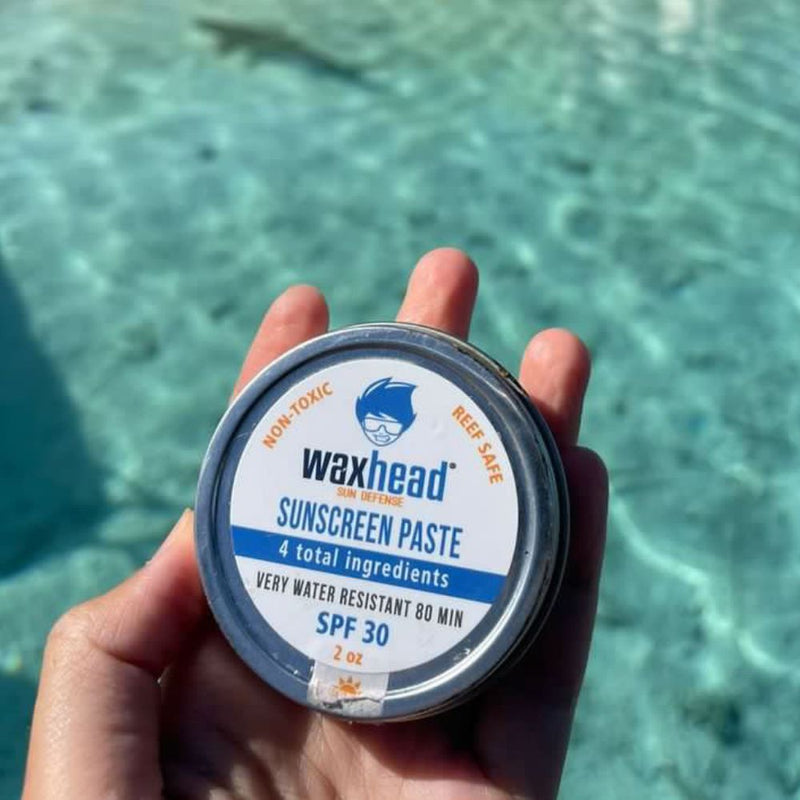Customers frequently ask questions about our products and other sunscreens. We are happy to provide insights into the pros and cons of any skincare product. The first step in evaluating another sunscreen is to research its ingredients. We then discuss each ingredient in detail and offer a straightforward, well-informed opinion.
Is Blue Lizard Sunscreen Reef Safe?
Let's dive in and learn more about Blue Lizard sunscreen, its ingredients, and whether it meets reef-safe criteria. Sunscreens like these play a crucial role in sun protection, but it's important to ensure they are safe for both people and the environment.
Step 1: Choosing a Blue Lizard Sunscreen to Analyze
For this evaluation, we selected Blue Lizard Active Mineral-Based Sunscreen Lotion SPF 50, which is an Amazon’s Choice product. Here is how Blue Lizard promotes its reef safety:
"We Love the Reef – To help protect delicate coral reefs, our Active sunscreen contains no Oxybenzone or Octinoxate."
"Blue Lizard's We Love the Reef sunscreens are Oxybenzone-free and Octinoxate-free for a swimming sunscreen that has delicate coral reefs in mind."
These claims are compelling but require deeper scrutiny to ensure their accuracy and alignment with what makes a sunscreen truly safe for reefs.
Step 2: Analyzing Blue Lizard's Ingredients
Active Ingredients
- Octisalate - 5%
- Titanium Dioxide - 5.4%
- Zinc Oxide - 10%
These active ingredients are designed to provide broad-spectrum protection against harmful UV light. However, their environmental impact depends largely on their specific formulations.
Inactive Ingredients
These include a variety of emollients, stabilizers, and other compounds, such as alumina, beeswax, caprylyl glycol, phenoxyethanol, and tocopheryl acetate, among others. While many of these are safe for humans, their impact on marine biosystems can be questionable. Understanding the full list of inactive ingredients is just as important as evaluating the active ones.
Step 3: Breaking Down the Active Ingredients
Octisalate
Octisalate is a chemical sunscreen ingredient that boosts UVB protection. At a 5% concentration, it reaches the FDA's allowable limit. However, it degrades in sunlight and is a known penetration enhancer, potentially allowing other harmful chemicals to enter the skin. Additionally, it is toxic to marine ecosystems and may contribute to coral bleaching.
Titanium Dioxide
Titanium dioxide is a mineral sunscreen ingredient but can cause oxidative damage when exposed to UV light. If used in nano form, it can harm coral reefs by inducing zooxanthellae expulsion, which leads to coral bleaching. Since Blue Lizard does not specify that its titanium dioxide is non-nano, we must assume it uses nanoparticles, raising concerns about its reef safety. Mineral sunscreen ingredients like non-nano titanium dioxide are safer alternatives.
Zinc Oxide
While zinc oxide is generally considered a safer mineral sunscreen ingredient, its safety depends on particle size. Non-nano zinc oxide is reef-safe, but nano-sized particles can damage marine life. Blue Lizard's packaging does not clarify whether its zinc oxide is non-nano, which raises doubts about its true reef-safe status. For individuals with sensitive skin, non-nano zinc oxide is also gentler and less likely to irritate.
Step 4: Final Verdict on Reef Safety
After evaluating the ingredients, we conclude that Blue Lizard Active Mineral-Based Sunscreen Lotion SPF 50 is not genuinely reef safe. The absence of oxybenzone and octinoxate is a positive step. Still, including other questionable ingredients and the lack of non-nano certifications for its minerals undermine its reef-safe claims.
It is important to note that the term "reef safe" is not regulated by the FDA. Many brands exploit this loophole, leading consumers to believe their products are ocean-friendly when they may not be.
True sun protection requires attention to both human health and environmental impact. For example, water resistance is a critical feature in sunscreen, but it must not come at the cost of coral reef safety.
Understanding Reef-Safe Sunscreen
A truly reef-safe sunscreen must meet these criteria:
- Contains only mineral active ingredients, such as zinc oxide or titanium dioxide.
- Uses non-nano particles, ensuring the ingredients do not harm marine life.
- Avoids all petrochemicals and toxic compounds, including octisalate.
Products marketed as reef-safe often fail to meet all these requirements. Always read labels carefully and look for certifications or clear statements about non-nano ingredients. Additionally, selecting products with SPF 30 or higher ensures adequate protection from harmful UV light without compromising marine safety.
Why Non-Nano Zinc Oxide is the Best Choice
Non-nano zinc oxide is the safest sunscreen active ingredient for humans and the environment. Its larger particle size prevents it from being absorbed through the skin or harming marine biosystems. Unlike chemical sunscreens, it provides broad spectrum protection against UV light without degrading in sunlight or causing coral bleaching.
When non-nano zinc oxide washes off in the ocean, it quickly settles to the seafloor and becomes an inert part of the sediment, posing no threat to marine ecosystems. For families and individuals looking for the best sun protection for sensitive skin, this ingredient is the most reliable and effective choice.
Trust Your Sunscreen
To ensure you're using a genuinely reef-safe sunscreen, always read the ingredient list and avoid products that include nano-sized minerals or toxic chemicals. If you have questions, feel free to ask us for guidance. We're here to help you make informed choices that prioritize both your health and the environment.
https://www.ncbi.nlm.nih.gov/pmc/articles/PMC5615097 https://oceanservice.noaa.gov/news/sunscreen-corals.htmlhttps://www.sustainabletourismhawaii.org/reefsafesunscreen





























